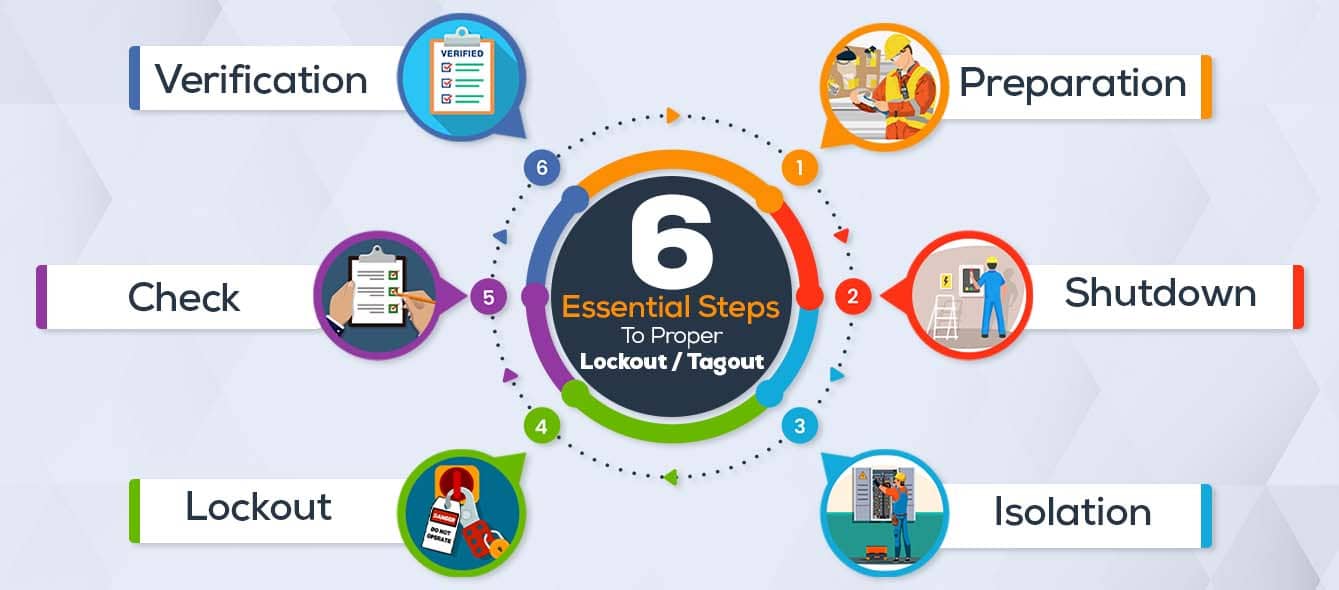
6 Essential Steps to Proper Lockout/Tagout
6 Essential Steps to Proper Lockout/Tagout

What are the Legal Requirements for Businesses?
Industrial equipment and machinery are typically large and complex, and multiple people from different trades are commonly involved when the equipment is shut down to be serviced, maintained, or repaired. It is essential for everyone concerned that the machinery is shut off and kept still while the task is being done.
Lockout Tagout (LOTO) safety training refers to one part of an energy control program that employers must establish for employees working in an organization. This training provides certain procedures to safeguard all workers from the unexpected start-up of machinery and equipment or the release of hazardous energy during service or maintenance.
6 Steps To Proper Lockout/Tagout
1. Preparation
The first step to completing proper lockout tagout is preparing the equipment to be powered off. During this preparation phase, an authorized or approved employee must conduct extensive research to understand all possible hazards associated with hazardous energy. It is essential to identify and monitor the risks.
2. Shutdown
Once the planning is complete, shut down machinery or equipment for maintenance. During this step, it is necessary that an authorized employee should inform other affected employees, even if they don’t have a role in maintenance or service.
3. Isolation
The next step of the Lockout/Tagout procedure or process is to isolate the machine or equipment from any energy source. This can be used to turn off power at a breaker or shutting a valve.
4. Lockout
The entire six-step process starts from this step. Once the machine or equipment has been isolated from its energy source, the authorized employee will attach lockout, Tagout device on the energy-isolating device so that it states in the “Safe” position and cannot be passed to an unsafe condition except by the person who performed the lockout.
The tag represents the additional information such as the name of the person who performed the lockout.
5. Check
It is essential to check for hazardous energy that has been stored inside the equipment, or “residual.” Any residual or stored energy that poses a risk but is not immediately dangerous must be eliminated, disconnected, restricted, or rendered harmless.
6. Verification
The final phase in lockout/tagout safety is verifying the machines have been locked out, shut down, or turned off, and the hazardous energy source has been removed. Check your work once more and make sure the machine or equipment can be used safely before moving further.
Who Need This LOTO Training?
Supervisor
contractors
Assembly line workers
Forklift operators
Machinists, welders
Authorized employees who performs the equipment service
Importance of LOTO Training
LOTO training helps to protect the employee from the release of hazardous energies while doing service or maintenance of machines or equipment.
It provides basic principles of safe work practices in high-voltage environments, including procedures for working safely around machinery and electrical power circuits
It helps to increases the company benefits and reduces the down-time and cost associated with fixing a machine.
Our Recent Projects

GreenWorldGroup Delivered a dynamic In company Face to face training on LOTO (Lockout Tagout) to the delegates of Amazon, Rajasthan.
Why Green World Group
Green World Group have been actively engaged in the training of employees across various organization We provide Lockout Tagout Safety Awareness Training Course through by our highly qualified and experienced training instructors with many years of experience and expertise in their field. We also Provide Various In-company training to corporate employees like Work at height, Fire Safety Audit, Risk Assessment, Confined Space and many other consultancy services…
 Supervisor
Supervisor
 NEBOSH CERTIFICATE
NEBOSH CERTIFICATE NEBOSH DIPLOMA
NEBOSH DIPLOMA IOSH
IOSH SAFETY DIPLOMA
SAFETY DIPLOMA CPD UK
CPD UK ROSPA UK
ROSPA UK FOOD SAFETY
FOOD SAFETY 



